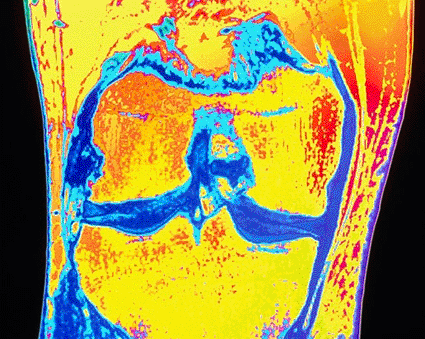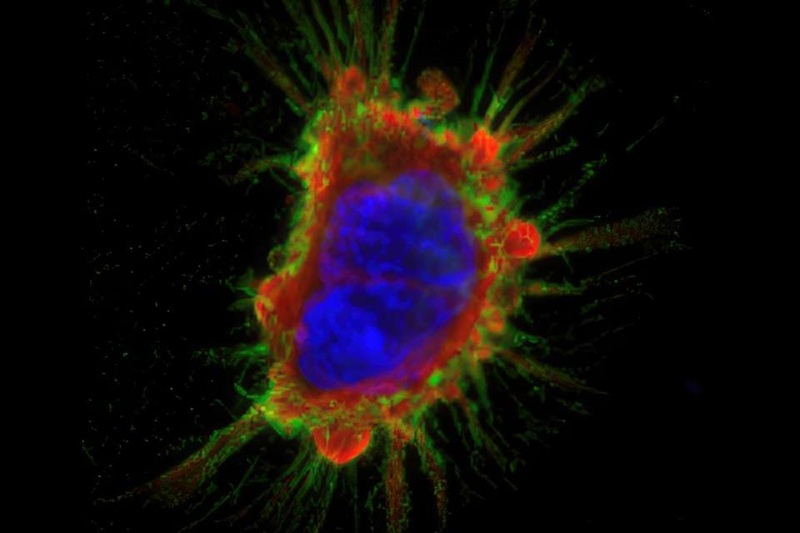Quantitative MRI Helps to Repair Damaged Knees
|
By MedImaging International staff writers Posted on 31 Jul 2009 |

Image: Colored magnetic resonance imaging (MRI) scan of the knee joint showing meniscus degeneration (Photo courtesy of Simon Fraser / SPL).
Investigators have shown that a biodegradable scaffold or plug can be used to treat patients with damaged knee cartilage. The study is unique in that it utilized serial magnetic resonance imaging (MRI) scanning and newer quantitative T2 mapping to examine how the plug incorporated itself into the knee.
The research findings were presented during the annual meeting of the American Orthopedic Society for Sports Medicine, June 9-12, 2009, in Keystone, CO, USA. "The data have been encouraging to support further evaluation of this synthetic scaffold as a cartilage repair technique,” said Asheesh Bedi, M.D., a fellow in sports medicine and shoulder surgery at the Hospital for Special Surgery (New York, NY, USA), who was involved with the study. Dr. Bedi performed analysis of MRI scans of patients primarily treated by Riley Williams, M.D., director of the Institute for Cartilage Repair at Hospital for Special Surgery. "The Trufit plug has been designed to have mechanical properties that are similar to cartilage and bone,” Dr. Bedi said.
Damage to so-called articular cartilage can occur in various ways, ranging from direct trauma in a motor vehicle accident to a noncontact, pivoting event on the soccer field. "Articular cartilage lacks the intrinsic properties of healing--you are essentially born with the articular cartilage that you have,” Dr. Bedi said. Left untreated, these injuries can increase loads placed on the remaining intact cartilage and increase the risk of progression to degenerative arthritis. One approach to treat patients with symptomatic chondral lesions is an OATS (osteoarticular transfer system) procedure, in which cartilage is transferred from one portion of the knee to treat another. Because this is a "robbing Peter to pay Paul” situation, researchers at Hospital for Special Surgery set out to evaluate whether they could use a biodegradable plug, the Trufit CB plug, to fill the donor site. The goal was to monitor how the plug incorporated itself into the knee and to assess the quality of the repair cartilage.
The Trufit plug has two layers. The top layer has properties similar to cartilage and the lower layer has properties similar to bone. The bilayered structure has mechanical properties that approximately match the adjacent cartilage and bone. Surgeons inserted the plug in the knees of 26 patients with donor lesions from OATS procedures and followed up with imaging studies (with MRI and T2-mapping) at various intervals for a period of 39 months.
"Quantitative MRI, when combined with morphologic assessment, allows us to understand the natural history of these repair techniques and define those patients who are most likely to benefit from the surgery,” said Hollis Potter, M.D., chief of the division of magnetic resonance imaging, director of research in the department of radiology and Imaging at Hospital for Special Surgery and lead author of the study. "We gain knowledge about the biology of integration with the host tissue, as well as the repair tissue biochemistry, all by a noninvasive imaging technique.”
"What we found was that the plug demonstrated a predictable process of maturation on imaging studies that paralleled the biology of their incorporation,” Dr. Bedi said. "With increasing postoperative duration, the repair tissue demonstrated encouraging properties with T2-values that resembled native articular cartilage.”
Dr. Williams, Dr. Bedi, and other surgeons at Hospital for Special Surgery are involved in ongoing studies to investigate the efficacy of the TruFit plug in treating primary cartilage defects as well. "What is unique about this study is that we have serial MRI with T2 mapping at various time points after surgery, which allows us to really examine the natural history of plug incorporation,” Dr. Bedi said.
Dr. Williams believes that there is a role for scaffold-based cartilage repair strategies in the treatment of symptomatic cartilage lesions. "It is our hope that we can successfully treat these cartilage problems over the long term, thus restoring normal knee function and slowing the progression of knee arthritis,” Dr. Williams said.
Related Links:
Hospital for Special Surgery
The research findings were presented during the annual meeting of the American Orthopedic Society for Sports Medicine, June 9-12, 2009, in Keystone, CO, USA. "The data have been encouraging to support further evaluation of this synthetic scaffold as a cartilage repair technique,” said Asheesh Bedi, M.D., a fellow in sports medicine and shoulder surgery at the Hospital for Special Surgery (New York, NY, USA), who was involved with the study. Dr. Bedi performed analysis of MRI scans of patients primarily treated by Riley Williams, M.D., director of the Institute for Cartilage Repair at Hospital for Special Surgery. "The Trufit plug has been designed to have mechanical properties that are similar to cartilage and bone,” Dr. Bedi said.
Damage to so-called articular cartilage can occur in various ways, ranging from direct trauma in a motor vehicle accident to a noncontact, pivoting event on the soccer field. "Articular cartilage lacks the intrinsic properties of healing--you are essentially born with the articular cartilage that you have,” Dr. Bedi said. Left untreated, these injuries can increase loads placed on the remaining intact cartilage and increase the risk of progression to degenerative arthritis. One approach to treat patients with symptomatic chondral lesions is an OATS (osteoarticular transfer system) procedure, in which cartilage is transferred from one portion of the knee to treat another. Because this is a "robbing Peter to pay Paul” situation, researchers at Hospital for Special Surgery set out to evaluate whether they could use a biodegradable plug, the Trufit CB plug, to fill the donor site. The goal was to monitor how the plug incorporated itself into the knee and to assess the quality of the repair cartilage.
The Trufit plug has two layers. The top layer has properties similar to cartilage and the lower layer has properties similar to bone. The bilayered structure has mechanical properties that approximately match the adjacent cartilage and bone. Surgeons inserted the plug in the knees of 26 patients with donor lesions from OATS procedures and followed up with imaging studies (with MRI and T2-mapping) at various intervals for a period of 39 months.
"Quantitative MRI, when combined with morphologic assessment, allows us to understand the natural history of these repair techniques and define those patients who are most likely to benefit from the surgery,” said Hollis Potter, M.D., chief of the division of magnetic resonance imaging, director of research in the department of radiology and Imaging at Hospital for Special Surgery and lead author of the study. "We gain knowledge about the biology of integration with the host tissue, as well as the repair tissue biochemistry, all by a noninvasive imaging technique.”
"What we found was that the plug demonstrated a predictable process of maturation on imaging studies that paralleled the biology of their incorporation,” Dr. Bedi said. "With increasing postoperative duration, the repair tissue demonstrated encouraging properties with T2-values that resembled native articular cartilage.”
Dr. Williams, Dr. Bedi, and other surgeons at Hospital for Special Surgery are involved in ongoing studies to investigate the efficacy of the TruFit plug in treating primary cartilage defects as well. "What is unique about this study is that we have serial MRI with T2 mapping at various time points after surgery, which allows us to really examine the natural history of plug incorporation,” Dr. Bedi said.
Dr. Williams believes that there is a role for scaffold-based cartilage repair strategies in the treatment of symptomatic cartilage lesions. "It is our hope that we can successfully treat these cartilage problems over the long term, thus restoring normal knee function and slowing the progression of knee arthritis,” Dr. Williams said.
Related Links:
Hospital for Special Surgery
Latest MRI News
- Novel Imaging Approach to Improve Treatment for Spinal Cord Injuries
- AI-Assisted Model Enhances MRI Heart Scans
- AI Model Outperforms Doctors at Identifying Patients Most At-Risk of Cardiac Arrest
- New MRI Technique Reveals Hidden Heart Issues
- Shorter MRI Exam Effectively Detects Cancer in Dense Breasts
- MRI to Replace Painful Spinal Tap for Faster MS Diagnosis
- MRI Scans Can Identify Cardiovascular Disease Ten Years in Advance
- Simple Brain Scan Diagnoses Parkinson's Disease Years Before It Becomes Untreatable
- Cutting-Edge MRI Technology to Revolutionize Diagnosis of Common Heart Problem
- New MRI Technique Reveals True Heart Age to Prevent Attacks and Strokes
- AI Tool Predicts Relapse of Pediatric Brain Cancer from Brain MRI Scans
- AI Tool Tracks Effectiveness of Multiple Sclerosis Treatments Using Brain MRI Scans
- Ultra-Powerful MRI Scans Enable Life-Changing Surgery in Treatment-Resistant Epileptic Patients
- AI-Powered MRI Technology Improves Parkinson’s Diagnoses
- Biparametric MRI Combined with AI Enhances Detection of Clinically Significant Prostate Cancer
- First-Of-Its-Kind AI-Driven Brain Imaging Platform to Better Guide Stroke Treatment Options
Channels
Radiography
view channel
X-Ray Breakthrough Captures Three Image-Contrast Types in Single Shot
Detecting early-stage cancer or subtle changes deep inside tissues has long challenged conventional X-ray systems, which rely only on how structures absorb radiation. This limitation keeps many microstructural... Read more
AI Generates Future Knee X-Rays to Predict Osteoarthritis Progression Risk
Osteoarthritis, a degenerative joint disease affecting over 500 million people worldwide, is the leading cause of disability among older adults. Current diagnostic tools allow doctors to assess damage... Read moreUltrasound
view channel
Wearable Ultrasound Imaging System to Enable Real-Time Disease Monitoring
Chronic conditions such as hypertension and heart failure require close monitoring, yet today’s ultrasound imaging is largely confined to hospitals and short, episodic scans. This reactive model limits... Read more
Ultrasound Technique Visualizes Deep Blood Vessels in 3D Without Contrast Agents
Producing clear 3D images of deep blood vessels has long been difficult without relying on contrast agents, CT scans, or MRI. Standard ultrasound typically provides only 2D cross-sections, limiting clinicians’... Read moreNuclear Medicine
view channel
PET Imaging of Inflammation Predicts Recovery and Guides Therapy After Heart Attack
Acute myocardial infarction can trigger lasting heart damage, yet clinicians still lack reliable tools to identify which patients will regain function and which may develop heart failure.... Read more
Radiotheranostic Approach Detects, Kills and Reprograms Aggressive Cancers
Aggressive cancers such as osteosarcoma and glioblastoma often resist standard therapies, thrive in hostile tumor environments, and recur despite surgery, radiation, or chemotherapy. These tumors also... Read more
New Imaging Solution Improves Survival for Patients with Recurring Prostate Cancer
Detecting recurrent prostate cancer remains one of the most difficult challenges in oncology, as standard imaging methods such as bone scans and CT scans often fail to accurately locate small or early-stage tumors.... Read moreGeneral/Advanced Imaging
view channel
3D Scanning Approach Enables Ultra-Precise Brain Surgery
Precise navigation is critical in neurosurgery, yet even small alignment errors can affect outcomes when operating deep within the brain. A new 3D surface-scanning approach now provides a radiation-free... Read more
AI Tool Improves Medical Imaging Process by 90%
Accurately labeling different regions within medical scans, a process known as medical image segmentation, is critical for diagnosis, surgery planning, and research. Traditionally, this has been a manual... Read more
New Ultrasmall, Light-Sensitive Nanoparticles Could Serve as Contrast Agents
Medical imaging technologies face ongoing challenges in capturing accurate, detailed views of internal processes, especially in conditions like cancer, where tracking disease development and treatment... Read more
AI Algorithm Accurately Predicts Pancreatic Cancer Metastasis Using Routine CT Images
In pancreatic cancer, detecting whether the disease has spread to other organs is critical for determining whether surgery is appropriate. If metastasis is present, surgery is not recommended, yet current... Read moreImaging IT
view channel
New Google Cloud Medical Imaging Suite Makes Imaging Healthcare Data More Accessible
Medical imaging is a critical tool used to diagnose patients, and there are billions of medical images scanned globally each year. Imaging data accounts for about 90% of all healthcare data1 and, until... Read more
Global AI in Medical Diagnostics Market to Be Driven by Demand for Image Recognition in Radiology
The global artificial intelligence (AI) in medical diagnostics market is expanding with early disease detection being one of its key applications and image recognition becoming a compelling consumer proposition... Read moreIndustry News
view channel
GE HealthCare and NVIDIA Collaboration to Reimagine Diagnostic Imaging
GE HealthCare (Chicago, IL, USA) has entered into a collaboration with NVIDIA (Santa Clara, CA, USA), expanding the existing relationship between the two companies to focus on pioneering innovation in... Read more
Patient-Specific 3D-Printed Phantoms Transform CT Imaging
New research has highlighted how anatomically precise, patient-specific 3D-printed phantoms are proving to be scalable, cost-effective, and efficient tools in the development of new CT scan algorithms... Read more
Siemens and Sectra Collaborate on Enhancing Radiology Workflows
Siemens Healthineers (Forchheim, Germany) and Sectra (Linköping, Sweden) have entered into a collaboration aimed at enhancing radiologists' diagnostic capabilities and, in turn, improving patient care... Read more


















